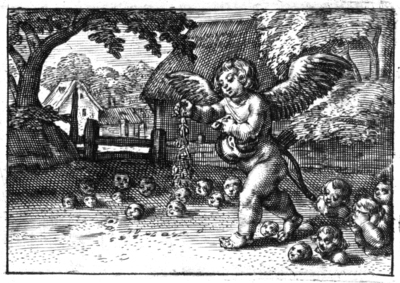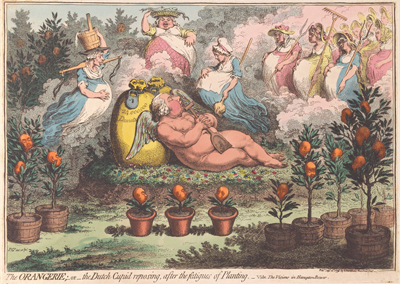The Orangerie, or the Dutch Cupid Reposing, after the Fatigues of Planting
If I am correct in assuming that Gillray etched the 20 plates of Hollandia Regenerata in July and August of 1796, the Orangerie would have been his next piece of work. And it is both fitting (and ironic) that he should have chosen this subject. Fitting, since Hollandia Regenerata was heavily influenced by the emblem book tradition, and, as Diana Donald notes, The Orangerie is itself a parody of a Dutch emblem showing Cupid as a sower of seed (Amoris Semen Mirabile) with little Cupid heads sprouting from the ground.

Daniël Heinsius, Ambacht van Cupido, from: Nederduytsche poemata (1616)
© Emblematica Online
But it is also ironic, because Gillray had just spent over two months etching David Hess's designs in Hollandia Regenerata satirizing the Batavian revolution which ousted William V, the "Dutch Cupid" shown here, and, in effect, arguing for his return. But now, freed to express his own opinion, Gillray creates a devastating image of the exiled Stadtholder as a serial philanderer, surrounded by the hugely pregnant women he has seduced and the ripening Orangist fruits of his labours.

[September 16, 1796]
© Beinecke Rare Book and Manuscript Library, Yale University
On January 18, 1795, the unpopular Stadtholder had fled from the Netherlands in a fishing boat as the French troops approached Amsterdam. He was generally welcomed in England, arriving at Kew on January 26, before moving to Hampton Court Palace on February 21 where apartments had been prepared for him and his family. His mother Ann was English after all, the eldest daughter of George II and so William V was a blood relation to the English King George III.
But as numerous contemporary accounts agree, he soon lost the respect of those with whom he came in contact. According to Sir Nathaniel Wraxhall, writing in 1815, "he neither inspired public respect nor excited private regard. His person, destitute of dignity, corresponded with his manners, which were shy, awkward, and altogether unfitted to his high situation as stadtholder." Ralph Fell in his A Tour through the Batavian Republic published in 1801, wrote that "after imbecility of understanding, [the Prince of Orange] has usually been accused of a passion for the pleasures of intoxication; and it is said that during the latter part of his government he was seldom sober." And when the Pitt government began its preparations for an invasion of Holland in 1799, there was no question of proposing the "despised Stadtholder William V" as a leader, according to Robin Reilly, "Comfortably installed at [Hampton Court Palace] he was more interested in the conquest of servant girls than in any effort to repossess himself of his country." Lord Holland, quoted by Draper Hill in Fashionable Contrasts agrees: "When the Prince of Orange resided at Hampton Court, his amours with the servant-maids were supposed to be very numerous."
According to Simon Schama, the other thing the Prince was interested in was getting an indemity, not only for the loss of his land and possessions but also "for the arrears of revenue, interest payments, perquisites, salaries, and so on which would have fallen due since 1795." (453). Gillray must have heard about the negotiations, so he portrays the Prince sleeping peacefully on bags of money labelled "24 million ducats." But this must have been part of the Stadtholder's dream of what he could get. The ultimate indemnification did not come until 1803 and was for only a fraction of that sum.
Sources and Reading
- Commentary from the British Museum on The Orangerie, or the Dutch Cupid Reposing, after the Fatigues of Planting.
- Draper Hill, Fashionable Contrasts, 1966, #64
- "William V, Prince of Orange," Wikipedia
- "Batavian Revolution," Wikipedia
- Ralph Fell, A Tour Through the Batavian Republic During the Latter Part of 1800, London 1801.
- Sir N. William Wraxhall, Historical Memoirs
- Robin Reilly, William Pitt the Younger, New York, 1979.
- Simon Schama, Patriots and Liberators: Revolution in the Netherlands 1780 - 1813, London, 1992
Comments & Corrections
NOTE: Comments and/or corrections are always appreciated. To make that easier, I have included a form below that you can use. I promise never to share any of the info provided without your express permission.